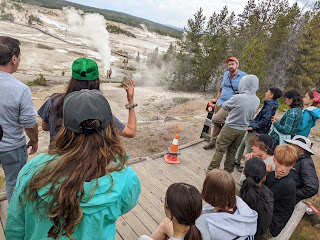After an early start to Day 6, we returned to our normal
wakeup time (7 AM). After breakfast, we moved our tents over to a neighboring
campground because our old campground reservation had expired.
Today was amphibian day so once we arrived at our new
campsite, we had a lesson on the importance of amphibian populations in
conservation science as well as how to identify the most common amphibian
species in Greater Yellowstone Ecosystem. We discussed the relevance of
amphibians as indicator species, as they are particularly sensitive to
environmental disruptions such as pollution (especially agricultural runoff),
precipitation changes, and invasive species. We went into detail about the
characteristics of the Western Toad, Plains Spadefoot, Boreal Chorus Frog,
Columbia Spotted Frog, Garter Snake, and Tiger Salamander.
After the lesson, we departed for a site about 20 minutes
from basecamp. From there, we hiked for a half hour up to a pond. On the hike,
we observed many different wildflower species such as bitterroot, lupine, and forget-me-nots.
Additionally, we saw an elk carcass on the way. It is likely that the animal
died in the winter but has since defrosted.
Once we arrived at the pond, we put on waders and had a
quick lunch. Then, we split into two groups and each travelled half of the pond,
starting at opposite ends, searching for amphibians of different life stages as
well as Wandering Garter Snakes. During our first survey, we found ten Garter
Snakes, five adult Columbia Spotted Frogs, three Tiger Salamander larvae, and
one Tiger Salamander metamorph. While not included in our data collection, one
group found and caught a large water spider with an egg sac. Unfortunately, we
had one casualty – Eric fell into the pond during data collection!





After taking a short break, making observations about the
site, and compiling our data, the two groups swapped sides of the pond and did
their second survey. At the end of that, we found eight Garter Snakes, two
adult Columbia Spotted Frogs, and one Colombia Spotted Frog larva. We had an
additional casualty during our second survey, as Tina fully submerged into the
pond as she fell. Throughout the surveys, both groups observed many leeches,
snails, and macroinvertebrates. While it threatened to rain multiple times
during our data collection, there were only a few minutes of drizzle, and much
of the day was spent in the hot sun.
After hiking back down from the pond, we assembled to work
on our research projects. We split up into our groups to formulate our guiding
research questions. We are working hard on our projects in three main research
categories: fire ecology, wolf biology, and amphibian-fungi interaction.
After a delicious dinner of Tikka Masala, we had our final
Quest for Knowledge! Kaileen, David, and Felipe led a very spirited game of
Yellowstone-themed Heads Up.













.jpg)
.jpg)








































